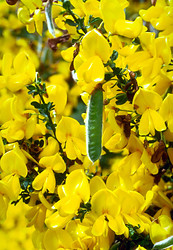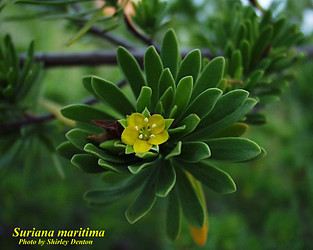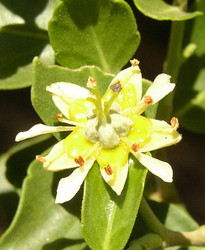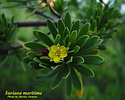Fabales
Martin F. Wojciechowski, Johanna Mahn, and Bruce Jones


This tree diagram shows the relationships between several groups of organisms.
The root of the current tree connects the organisms featured in this tree to their containing group and the rest of the Tree of Life. The basal branching point in the tree represents the ancestor of the other groups in the tree. This ancestor diversified over time into several descendent subgroups, which are represented as internal nodes and terminal taxa to the right.

You can click on the root to travel down the Tree of Life all the way to the root of all Life, and you can click on the names of descendent subgroups to travel up the Tree of Life all the way to individual species.
For more information on ToL tree formatting, please see Interpreting the Tree or Classification. To learn more about phylogenetic trees, please visit our Phylogenetic Biology pages.
close boxIntroduction
The traditional orders Fabales, Rosales, Cucurbitales, and Fagales comprise one of the major clades within Eurosids I. This clade is characterized by the ability of many of its members to fix atmospheric nitrogen (N2) to a form usable by plants (Soltis et al. 2000). Within this ‘nitrogen-fixing’ clade the monophyly of each of its subclades receives strong support from analyses of molecular data. The monophyly of Fabales (sensu Angiosperm Phylogeny Group, 2003) and a sister group relationship of legumes (family Fabaceae) to the families Quillajaceae, Polygalaceae, and Surianaceae, are all strongly supported (Doyle et al. 2000), but the relationship among these lineages is not clearly resolved at the present time.
Discussion of Phylogenetic Relationships
Within angiosperms, Fabaceae has traditionally been considered ‘rosid’ in its taxonomic relationships, with Connaraceae, Chrysobalanaceae, Crossosomataceae, Krameriaceae, and even Sapindaceae suggested as closely related families (potential sister groups) by different authors at one time or another (reviewed by Dickison, 1981; Thorne, 1992). The first challenge to these hypotheses came from the now landmark study of Chase et al. (1993) based on cladistic analysis of the chloroplast rbcL gene, which suggested Polygalaceae and Surianaceae as potential sister groups to Fabaceae and resolved the other families as more distantly related. A close relationship of Fabaceae to Polygalaceae (and Surianaceae) within a more inclusive Fabales clade has been substantiated by most subsequent angiosperm-wide analyses of molecular data (Savolainen et al., 2000; Soltis et al., 2000). In addition, studies focused on relationships within rosids (Soltis et al., 1995; Steele et al., 2000; Persson, 2001) have shown the rosacean genus Quillaja Molina strongly supported as a member of Fabales, although relationships within Fabales are still only weakly resolved.
References
Angiosperm Phylogeny Group [APG]. 2003. An update of the Angiosperm Phylogeny Group classification for the orders and families of flowering plants: APG II. Botanical Journal of the Linnean Society 141: 399-436.
Crayn, D. M., E. S. Fernando, P.A. Gadek, and C.J. Quinn. 1995. A reassessment of the familial affinity of the Mexican genus Recchia Moçiño & Sessé ex DC. Brittonia 47: 397-402.
Doyle, J. J., J. A. Chappill, C.D. Bailey, and T. Kajita. 2000. Towards a comprehensive phylogeny of legumes: evidence from rbcL sequences and non-molecular data. Pages 1-20 in Advances in legume systematics, part 9 (P.S. Herendeen and A. Bruneau, eds.). Royal Botanic Gardens, Kew, UK.
Fernando, E.S., P. A. Gadek, D. M. Crayn, and C. J. Quinn. 1993. Rosid affinities of Surianacae: molecular evidence. Molecular Phylogenetics and Evolution 2: 344 – 350.
Lotova, L. I. and A. C. Timonin. 1999. Anatomy of cortex and secondary phloem in Rosaceae. 3. Quillajoideae. Bot. Zhurn. 84 (2): 34-41.
Persson, C. 2001. Phylogenetic relationships in Polygalaceae based on plastid DNA sequences from the trnL-F region. Taxon 50: 763-779.
Robertson, K. R. 1974. The genera of the Rosaceae in the southeastern United States. J. Arnold Arboretum 55: 303-401, 611-662.
Savolainen, V., M.W. Chase, S.B. Hoot, C.M. Morton, D.E. Soltis, C. Bayer, M.F. Fay, A.Y. De Bruijn, S. Sullivan, and Y.L. Qiu. 2000a. Phylogenetics of flowering plants based on combined analysis of plastid atpB and rbcL gene sequences. Systematic Biology 49:306-362.
Savolainen, V., M. F. Fay, D. C. Albach, A. Backlund, M. van der Bank, K. M. Cameron, S. A. Johnson, M. D. Lledó, J.-C. Pintaud, M. Powell, M. C. Sheahan, D. E. Soltis, P. S. Soltis, P. Weston, W. M. Whitten, K. J. Wurdack, and M. W. Chase. 2000b. Phylogeny of the eudicots: a nearly complete familial analysis based on rbcL gene sequences. Kew Bulletin 55:257-309.
Soltis, D. E., P. S. Soltis, M. W. Chase, M. E. Mort, D. C. Albach, M. Zanis, V. Savolainen, W. H. Hahn, S. B. Hoot, M. F. Fay, M. Axtell, S. M. Swensen, L. M. Prince, W. J. Kress, K. C. Nixon, and J. S. Farris. 2000. Angiosperm phylogeny inferred from 18S rDNA, rbcL, and atpB sequences. Botanical Journal of the Linnean Society 133:381-461.
Takhtajan, Armen. 1997. Diversity and classification of flowering plants. Columbia University Press, New York.
Zhang, S.-Y. 1992. Systematic wood anatomy of the Rosaceae. Blumea 37: 81-158.
Information on the Internet
- Angiosperm Phylogeny Website; search on "Fabales"
- International Legume Database & Information Service
Title Illustrations

| Scientific Name | Cytisus scoparius |
|---|---|
| Acknowledgements | Photograph courtesy InsectImages.org (#0022099) |
| Specimen Condition | Live Specimen |
| Source Collection | Bugwood Network/Forestry Images |
| Copyright | © Eric Coombs, Oregon Department of Agriculture |
| Scientific Name | Quillaja saponaria Poir. |
|---|---|
| Specimen Condition | Live Specimen |
| Copyright | © 2003-2006 David L. Magney |
About This Page
Martin F. Wojciechowski

Arizona State University, Tempe, Arizona, USA
Bruce Jones

Arizona State University
Correspondence regarding this page should be directed to Martin F. Wojciechowski at , Johanna Mahn at , and Bruce Jones at
Page copyright © 2009 Martin F. Wojciechowski, , and
All Rights Reserved.
- Content changed 14 June 2006
Citing this page:
Wojciechowski, Martin F., Johanna Mahn, and Bruce Jones. 2006. Fabales. Version 14 June 2006 (under construction). http://tolweb.org/Fabales/21030/2006.06.14 in The Tree of Life Web Project, http://tolweb.org/











 Go to quick links
Go to quick search
Go to navigation for this section of the ToL site
Go to detailed links for the ToL site
Go to quick links
Go to quick search
Go to navigation for this section of the ToL site
Go to detailed links for the ToL site